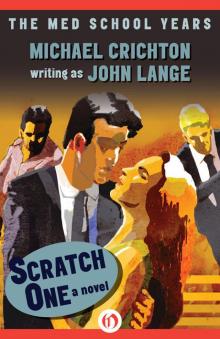- Home
- Michael Crichton
Five Patients Page 5
Five Patients Read online
Page 5
Page 5
In this light, consider Mr. OConnors antibiotic "cocktail," given shortly after admission. It was later the subject of some heated discussion when, during the first two or three days, he failed to improve.
The use of antibiotics is more sophisticated now than it was twenty years ago, corresponding to a better appraisal of the benefits and limitations of the drugs. Generally speaking, the antibiotic cocktail, a mixture of drugs given before one has diagnosed the nature of the infection, is frowned upon. The arguments against it are simple enough. For Mr. OConnor, the mixture of antibiotics might not eliminate the primary site of infection-but it would certainly kill all free bacteria in the blood, thus making identification of the organisms impossible. Without identification, one cannot treat specifically, by matching the organism with the single most effective antibiotic. Further, the inability to identify the organism deprives doctors of an important clue to the location of the infection, since different organisms are more likely to infect different parts of the body.
The arguments in favor of the cocktail are equally simple: that Mr. OConnors fever was, in itself, dangerous and constituted a medical emergency. The first duty of the EW residents, as they saw it, was to lower that fever by every possible means, even if this hampered further diagnostic efforts. As one resident said, "He could have died while we waited for the cultures to grow out. "
It all comes back to Hippocrates: Does one treat with a grave remedy, or a specific one? The MGH chose a grave remedy, a strong antibiotic cocktail. The residents did so with the full knowledge that it might impair further work.
Let us now see what happened to Mr. OConnor.
Chapter 3
Day I
Mr. OConnor survived the night. The following morning his blood pressure was normal and his temperature was 99 , but he remained severely agitated and unresponsive. He was sedated with morphine, continued on intravenous fluids and electrolyte supplements. The oxygenation of his blood had been poor from the start and he was continued on oxygen by face mask.
At eight in the morning the genito-urinary consult saw him and felt that he had peritonitis of the right abdomen, or infection of the sac-like membrane which surrounds the abdominal contents. Evidence included tenderness and muscle spasm on the right side, and tenderness when his liver was tapped. Bowel sounds were decreased, suggestive of intra-abdominal infection. There was tenderness to rectal examination, also suggestive of such infection.
At nine, Dr. Minna examined the patient again and agreed that the tenderness was impressive, particularly after a heavy dose of morphine. An X-ray study of the gall bladder was planned. At eleven, he was seen by the surgeons who agreed that gall-bladder infection was possible, even though bilirubin and amylase tests were normal. They advised waiting on surgery, however.
At noon, the gastrointestinal consult reviewed the barium enema, which was normal. They concluded that "we remain in the dark regarding diagnosis but would agree that bacterial sepsis secondary to a right abdominal lesion is the best bet. " They suggested, however, that perforated small bowel, duodenal lesion, pancreatitis, and a number of other possibilities remained, and advised an upper GI series of X rays.
At approximately the same time, the attending physician on the wards, Dr. Kurt Bloch, noted that Mr. OConnor presented "a very puzzling problem," with some findings suggestive of right-upper-abdomen pathology, but no clear indication of what it might be.
Later in the day the surgeons again saw Mr. OConnor, but disagreed with earlier interpretations. They felt his abdomen had no peritoneal signs, and no localizing signs.
At eight in the evening, the neuromedical consult again evaluated Mr. OConnor, and concluded that his condition still gave no hint of central nervous system disease. They felt that findings pointed to an abdominal problem.
That same evening, more abnormal laboratory values came back from the labs. They had been taken the day of admission, and included an elevated uric acid level of 17. 1 and an elevated alkaline phosphatase level of 37. 6. The alkaline phosphatase test was repeated, and was found to be still higher, at 61. 0. Two other enzymes were also slightly high: the serum glutamic oxalocetic transaminase, or SGOT, was 123, and the lactic dehydrogenase, or LDH, was 540. Blood samples were immediately drawn for repeat determinations.
These two enzymes, SGOT and LDH, are measured as indexes of cell destruction. Cells normally contain them; if the cells die, they rupture and release their enzymes to the bloodstream. A rise in enzyme levels is thought to correspond moderately well with the degree of cellular damage, particularly when examined over several days. However, these enzymes are found in many kinds of cells, and thus an enzyme rise does not pinpoint precisely the area of destruction. For example, heart, skeletal muscle, brain, liver, and kidneys all contain SGOT; damage to any of them will produce an SGOT rise. In recent years, there has been a search for enzymes specific to certain tissues. Cre-atinine phosphokinase, or CPK, is usually considered more specific for heart damage.
Chapter 4
Day 2
At 3:30 a. m. , Michael Soper, a medical resident, got back the new set of enzyme values. Everything was further increased: SGOT was now 640, LDH 1250, and CPK very high, at 320. He wrote: "Ive never seen a CPK this high and dont know where it is coming from. Doubt it is solely of cardiac origin. Electrocardiogram tonight is unchanged. "
At 7 a. m. , on morning rounds, Mr. OConnors abdomen was again without localizing signs pointing to disease on the right side. All cultures were back from the labs; all were negative. It was decided to continue only penicillin and chloramphen-icol, and discontinue all other antibiotics.
Later in the morning, the patient was seen by the infectious-disease consult, which concluded that the agitation and unresponsiveness were almost certainly secondary to gastrointestinal disorders and metabolic problems. The elevated enzymes could be the consequence of insufficient oxygen and shock, present at admission. However, they noted that the elevated alkaline phosphatase and elevated uric acid were unexplained. They suggested the possibility, previously unconsidered, of staphylococcal food poisoning.
Since no information could be obtained directly from the patient, his wife was closely requestioned about symptoms of thyroid disease, or longstanding diarrhea or other GI problems. The paregoric that the patient had taken on the day of admission was brought into the hospital and checked; it was, indeed, paregoric.
During this period the patient was examined by Dr. Alexander Leaf, the chief of medicine, and Dr. Daniel Federman, the assistant chief, as well as by a large number of other physicians, in an informal brainstorming session. Every conceivable diagnosis, including mushroom poisoning and cholera, was considered at this time.
The patients condition remained unchanged.
Day 3
Continued problems with oxygenating the patients bloodstream produced a consultation by the respiratory unit, which advised drying the lungs as much as possible, naso-tracheal suctioning, encouraging coughing, and close monitoring by arterial blood gases. The patient improved somewhat during the day, becoming less wild. That evening, for the first time, he responded to his name.
Day 4
The patient was more alert. He was seen again by the surgeons, who noted his abdomen was still soft, without any indications for surgery. His dose of Valium, to contain his agitation, was reduced.
Day 5
He was seen in the morning by the neurological consults, who felt that he was "still quite ob-tunded," confused and disoriented. Nonetheless his progress since admission was striking. He could answer questions. When asked where he was, he said, "the hospital," though he could not specify which one. When asked his name, he said, "John. " He could state his age. He was taken off Valium entirely. His temperature continued to fluctuate in the range of 99 -101 F. Dr. Minna wrote: "He is better in all ways. "
Day 6
Lab values, back from the day before, continued to climb. CPK had now gone to 2900, the highest
in the history of the hospital. There was still no explanation for these enzyme changes. The patient continued to improve in alertness and responsiveness, though his mental function was far from satisfactory. In answer to questions, he said that one plus one was "one," and two plus two was "five. "
Day 7
He was able to carry out verbal commands such as "Squeeze my hand" and "Open your eyes. " However, for the most part he lay in bed with his eyes closed; he initiated little spontaneous activity, and never spoke except in reply to questions.
Day 8
His Foley catheter was removed. He was able to urinate in the normal manner. He was more active mentally, and remembered his last name, for the first time.
Day 9
Blood cultures now revealed growth of a gram-negative bacillus, identified as Bacteroides, probably of bowel origin. The patient was sufficiently improved that he could be questioned about toxins, drugs, mushrooms, work exposure, and possible ingestions of heavy metals; there was no evidence for any of these. He was seen again by surgeons, who concluded that his abdomen was soft, with normal bowel sounds.
Day 13
Barium enema was repeated, looking for diver-ticulitis or other sources of infection. None was seen.
Day 10
He was seen by the neurological consults, who observed mild proximal muscle weakness and suggested study of the electrical activity of the muscles, by electromyography. He was also noted to have mushy swelling of his extremities.
Day 14
Electromyography was normal. It was decided to discontinue his chloramphenicol antibiotic and see if he remained without fever.
Day 15
Chloramphenicol was stopped. The patient did well, taking liquids by mouth.
Day 11
The patients mental condition continued to improve. A repeat kidney X ray was read as normal.
Day 16
On his second day off antibiotics, his temperature fluctuated in the range of 1000-101 F.
Day 12
There was continued improvement. Enzymes had dropped to near-normal levels. He had no fever.
Day 17
The patient had an upper gastrointestinal series of X rays, which were normal. On his third day off antibiotics, the temperature began to spike again, to 102 . Tenderness and guarding of the right-upper abdomen reappeared.
Day 18
The surgeons concluded that the patient had cholecystitis, or infection of the gall bladder, which had probably begun initially as cholangitis, infection of the bile system. They also wondered, however, whether he might have a liver abscess. The patient was put back on antibiotics.
Day 19
Mr. OConnor was transferred from the medical service to the surgical service as a pre-operative candidate for exploratory abdominal surgery. His mental state continued to clear slowly.
Day 20
The neurological consult saw him and agreed his mental status was improving. The surgeons, moreover, found that his abdominal tenderness had disappeared with the antibiotics. X rays of the gall bladder showed no filling of the bladder sac, but the films were of poor quality. Radioactive scans of the liver and spleen were negative.
Day 21
The scheduled operation was canceled in order to allow time for further pre-operative studies. A repeated gall bladder X ray definitely showed no filling, although this time the films were of good quality. A celiac angiogram was scheduled.
Day 22 and Day 23
The weekend. Specialized procedures such as celiac angiography could not be done, and further work on the patient was postponed until Monday.
Day 24
Celiac angiography was performed. Under local anesthetic, a thin, flexible catheter was passed up the femoral artery in the leg, to the aorta, and finally to the celiac axis, a network of arteries coming off the aorta to supply blood to all the upper-abdominal organs. A dye opaque to X rays was injected, and the vessels studied. No space-occupying lesion (tumor) was found and the vessels were normal in appearance. The patient made a good recovery from the procedure.
Day 25
The abdomen was soft and non-tender. The patient felt well. He was still on chloramphenicol. Enzymes were, by now, fully normal.
Day 26
The patient had no fever and felt well. The surgical staff decided to stop antibiotics and see if the fever and symptoms recurred. was now clear that he was not an operative candidate. Plans were made for his discharge the following day.
Day 27
He was taken off antibiotics. Temperature and white cell count remained normal. The patient himself was in good spirits.
Day 28
There was no demonstrable worsening of the patients condition on his second day off antibiotics. His wife expressed the opinion that his mental state was entirely normal once more.
Day 29
His condition remained stable on the third day. He said he felt well. He had no fever and no elevation in white count.
Day 30
His condition was still good; his abdomen was soft without tenderness. He said he felt well. It
Chapter 5
Day 31
Discharged. His discharge diagnosis was fever of unknown origin with bacteroides septicemia. The opinion of the house staff remained that this patient had probably had a bile-collecting-system infection.
Five days after discharge, he was seen in the surgical clinic by Dr. Jack Monchik, who scheduled another set of gall bladder X rays for the future, and noted that if the patient had further trouble with infection, it would probably be necessary to remove the gall bladder. For the moment, however, the patient was fully well.
"To do nothing," said Hippocrates, "is sometimes a good remedy. "
On the surface, Mr. OConnors hospital course seems proof of this ancient dictum of "watchful waiting. " But this is not really so: had Mr. OConnor received no treatment, he would almost certainly have died within twenty-four hours. He received vital symptomatic therapy (lowering his fever) as well as acute support of vital functions (assisted respiration). He was closely monitored by teams of physicians who were prepared to intercede in his behalf, supplying more assistance should his body require it.
He also received a vigorous diagnostic work-up, which did not produce as much information as one might like. His therapy was successful, but no physician at the hospital could claim, at discharge, that they really knew what was going on in his case. A diagnosis of cholangitis and cholecystitis was likely, but never demonstrated.

 Dragon Teeth
Dragon Teeth Jurassic Park
Jurassic Park Micro
Micro The Great Train Robbery
The Great Train Robbery The Andromeda Strain
The Andromeda Strain The Lost World
The Lost World Congo
Congo Travels
Travels Timeline
Timeline Sphere
Sphere Westworld
Westworld Prey
Prey State Of Fear
State Of Fear Next
Next Disclosure
Disclosure Pirate Latitudes
Pirate Latitudes The Terminal Man
The Terminal Man Five Patients
Five Patients Rising Sun
Rising Sun Binary
Binary The Andromeda Evolution
The Andromeda Evolution Airframe
Airframe Easy Go
Easy Go Drug of Choice
Drug of Choice Odds On: A Novel
Odds On: A Novel Scratch One
Scratch One Dealing or The Berkeley-to-Boston Forty-Brick Lost-Bag Blues
Dealing or The Berkeley-to-Boston Forty-Brick Lost-Bag Blues Venom Business
Venom Business Grave Descend
Grave Descend Gold - Pirate Latitudes
Gold - Pirate Latitudes Binary: A Novel
Binary: A Novel Zero Cool
Zero Cool Delos 1 - Westworld
Delos 1 - Westworld